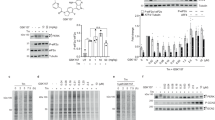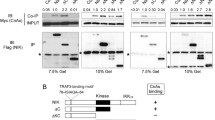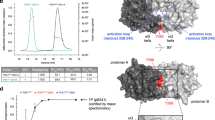Abstract
Treatment of human osteosarcoma cell line MG63 cells with okadaic acid stimulated phosphorylation of IκBα, as judged from the results of Western blot analysis and a λ protein phosphatase dephosphorylation assay. The stimulated phosphorylation of IκBα was both time- and dose-dependent. The phosphorylation sites of IκBα were taken to be tyrosine residues because the anti-phospho-tyrosine antibody bound to the samples immunoprecipitated with the anti-IκBα antibody. In the cells treated with 100 nM okadaic acid consequential translocation of NF-κB p65 from the cytosol to the nucleus occurred. Double-stranded RNA-dependent protein kinase (PKR) is a player in the cellular antiviral response and is involved in transcriptional stimulation through activation of NF-κB. We investigated the functional relationship between PKR and IκBα phosphorylation by constructing MG63 PKR K/R cells that produced a catalytically inactive mutant PKR. NF-κB p65 was detected in the nucleus of these cells, even in the unstimulated cells. Although IκBα was degraded phosphorylation of eIF-2α, a substrate of PKR, did not occur in the mutant cells treated with okadaic acid. Our results suggest that okadaic acid-induced tyrosine phosphorylation of IκBα was mediated by PKR kinase activity, thus indicating the involvement of this kinase in the control mechanism governing the activation of NF-κB. (Mol Cell Biochem 276: 211–217, 2005)
Similar content being viewed by others
References
Fernandez JJ, Candenas ML, Souto ML, Trujillo MM, Norte M: Okadaic acid, useful tool for studying cellular processes. Curr Med Chem 9: 229–262, 2002
Morimoto Y, Ohba T, Kobayashi S, Haneji T: The protein phosphatase inhibitors okadaic acid and calyculin A induce apoptosis in human osteoblastic cells. Exp Cell Res 230: 181–186, 1997
Morimoto H, Morimoto Y, Ohba T, Kido H, Kobayashi S, Haneji T: Inhibitors of protein synthesis and RNA synthesis protect against okadaic acid-induced apoptosis in human osteosarcoma cell line MG63 cells but not in Saos-2 cells. J Bone Miner Metab 17: 266–273, 1999
Kito S, Shimizu K, Okamura H, Yoshida K, Morimoto H, Fujita M, Morimoto Y, Ohba T, Haneji T: Cleavage of nucleolin and argyrophilic nucleolar organizer region associated proteins in apoptosis-induced cells. Biochem Biophys Res Commun 300: 950–956, 2003
Fujita M, Seta C, Fukuda J, Kobayashi S, Haneji T: Induction of apoptosis in human oral squamous carcinoma cell lines by protein phosphatase inhibitors. Oral Oncol 35: 401–408, 1999
Goto K, Fukuda J, Haneji T: Okadaic acid stimulates apoptosis through expression of Fas receptor and Fas ligand in human oral squamous carcinoma cells. Oral Oncol 38: 16–22, 2002
Fujita M, Goto K, Yoshida K, Okamura H, Morimoto H, Kito S, Fukuda J, Haneji T: Okadaic acid stimulates expression of Fas receptor and Fas ligand by activation of nuclear factor kappa-B in human oral squamous carcinoma cells. Oral Oncol 40: 199–206, 2004
Okamura H, Yoshida K, Sasaki E, Morimoto H, Haneji T: Transcription factor NF-Y regulates mdr1 expression through binding to inverted CCAAT sequence in drug-resistant human squamous carcinoma cells. Int J Oncol 25: 1031–1037, 2004
Morimoto Y, Morimoto H, Kobayashi S, Ohba T, Haneji T: The protein phosphatase inhibitors, okadaic acid and calyculin A, induce apoptosis in human submandibular gland ductal cell line HSG cells. Oral Dis 5: 104–110, 1999
Pahl HL: Activators and target genes of Rel/NF-κB transcription factors. Oncogene 18: 6853–6866, 1999
Gilmore T, Gapuzan ME, Kalaitzidis D, Starczynowski D: Rel/NF-κB/IκB signal transduction in the generation and treatment of human cancer. Cancer Lett 181: 1–9, 2002
Karin M, Lin A: NF-κB at the crossroads of life and death. Nature Immunol 3: 221–227, 2002
Barkett M, Gilmore TD: Control of apoptosis by Rel/NF-κB transcription factors. Oncogene 18: 6910–6924, 1999
Didonato J, Mercurio F, Rosette C, Wu-Li J, Suyang H, Ghosh S, Karin M: Mapping of the inducible IκB phosphorylation sites that signal its ubiquitination and degradation. Mol Cell Biol 16: 1295–1304, 1996
Imbert V, Rupec RA, Livolsi A, Pahl HL, Traenckner EBM, Mueller-Dieckmann C, Farahifar D, Rossi B, Auberger P, Baeuerle PA, Peyron JF: Tyrosine phosphorylation of IκB-κ activates NF-κB without proteolytic degradation of IκB-κ. Cell 86: 787–798, 1996
Zwacka RM, Zhang Y, Zhou W, Halldorson J, Engelhardt J: Ischemia/Reperfusion injury in the liver of BALB/c mice activates AP-1 and nuclear factor κB independently of IκB degradation. Hepatology 28: 1022–1030, 1998
Fan C, Li Q, Ross D, Engelhardt JF: Tyrosine phosphorylation of IκBκ activates NFκB through a redox-regulated and c-Src-dependent mechanism following hypoxia/reoxygenation. J Biol Chem 278: 2072–2080, 2003
Abu-Amer Y, Ross FP, McHugh KP, Livolsi A, Peyron JF, Teitelbaum SL: Tumor necrosis factor-κ activation of nuclear transcription factor-κB in marrow macrophages is mediated by c-Src tyrosine phosphorylation of IκBκ. J Biol Chem 273: 29417–29423, 1998
Livolsi A, Busuttil V, Imbert V, Abraham RT, Peyron JF: Tyrosine phosphorylation-dependent activation of NF-κB. Requirement for p56 LCK and ZAP-70 protein tyrosine kinase. Eur J Biochem 268: 1508–1515, 2001
Takada Y, Mukhopadhyay A, Kundu GC, Mahabeleshwar GH, Singh S, Aggarwal BB: Hydrogen peroxide activates NF-κB through tyrosine phosphorylation of IκBκ and serine phosphorylation of p65. J Biol Chem 278: 24233–24241, 2003
Jagus R, Joshi B, Barber GN: PKR, apoptosis and cancer. Int J Biochem Cell Biol 31: 123–138, 1999
Williams BRG: PKR; a sentinel kinase for cellular stress. Oncogene 18: 6112–6120, 1999
Haro CD, Méndez R, Santoyo J: The eIF-2κ kinases and the control of protein synthesis. FASEB J 10: 1378–1387, 1996
Yeung MC, Liu J, Lau AS: An essential role for the interferon-inducible, double-stranded RNA-activated protein kinase PKR in the tumor necrosis factor-induced apoptosis in U937 cells. Proc Natl Acad Sci USA 93: 12451–12455, 1996
Der SD, Yang YL, Weissmann C, Williams BRG: A double-stranded RNA-activated protein kinase-dependent pathway mediating stress-induced apoptosis. Proc Natl Acad Sci USA 94: 3279–3283, 1997
Kaufman RJ: Double-stranded RNA-activated protein kinase mediates virus-induced apoptosis: a new role for an old actor. Proc Natl Acad Sci USA 96: 11693–11695, 1999
Gil J, Esteban M: Induction of apoptosis by the dsRNA-dependent protein kinase (PKR): Mechanism of action. Apoptosis 5: 107–114, 2000
Saelens X, Kalai M, Vandenabeele P: Translation inhibition in apoptosis caspase-dependent PKR activation and eIF2-κ phosphorylation. J Biol Chem 276: 41620–41628, 2001
Szyszka R, Kudlicki W, Kramer G, Hardesty B, Galabru J, Hovanessian A: A type 1 phosphoprotein phosphatase active with phosphorylated M r = 68,000 initiation factor 2 kinase. J Biol Chem 264: 3827–3831, 1989
Jammi NV, Beal PA: Phosphorylation of the RNA-dependent protein kinase regulates its RNA-binding activity. Nucleic Acids Res 14: 3020–3029, 2001
Tan SL, Tareen SU, Melville MW, Blakely CM, Katze MG: The direct binding of the catalytic subunit of protein phosphatase 1 to the PKR protein kinase is necessary but not sufficient for inactivation and disruption of enzyme dimer formation. J Biol Chem 277: 36109–36117, 2002
Donzé O, Deng J, Curran J, Sladek R, Picard D, Sonenberg N: The protein kinase PKR: a molecular clock that sequentially activates survival and death programs. EMBO J 23: 564–571, 2004
Taddeo B, Luo TR, Zhang W, Roizman B: Activation of NF-κB in cells productively infected with HSV-1 depends on activated protein kinase R and plays no apparent role in blocking apoptosis. Proc Natl Acad Sci USA 100: 12408–12413, 2003
Kumar A, Haque J, Lacoste J, Hiscott J, Williams BRG: Double-stranded RNA-dependent protein kinase activates transcription factor NF-κB by phosphorylating IκB. Proc Natl Acad Sci USA 91: 6288–6292, 1994
Morimoto H, Okamura H, Yoshida K, Kitamura S, Haneji T: Okadaic acid induces apoptosis through double-stranded RNA-dependent protein kinase/eukaryotic initiation factor-2κ pathway in human osteoblastic MG63 cells. J Biochem (Tokyo) 136: 433–438, 2004
Meurs E, Chong K, Galabru J, Thomas NSB, Kerr IM, Williams BRG, Hovanessian AG: Molecular cloning and characterization of the human double-stranded RNA-activated protein kinase induced by interferon. Cell 62: 379–390, 1990
Takizawa T, Ohashi K, Nakanishi Y: Possible involvement of double-stranded RNA-activated protein kinase in cell death by influenza virus infection. J Virol 70: 8128–8132, 1996
Miskolci V, Castro-Alcaraz S, Nguyen P, Vancura A, Davidson D, Vancurova I: Okadaic acid induces sustained activation of NFκB and degradation of the nuclear IκBκ in human neutrophils. Arch Biochem Biophys 417: 44–52, 2003
Sonoda Y, Kasahara T, Yamaguchi Y, Kuno K, Matsushima K, Mukaida N: Stimulation of interleukine-8 production by okadaic acid and vanadate in a human promyelocyte cell line, an HL-60 subline. J Biol Chem 272: 15366–15372, 1997
Schmidt, KN, Traenckner EBM, Meier B, Baeuerle PA: Induction of oxidative stress by okadaic acid is required for activation of transcription factor NF-κB. J Biol Chem 270: 27136–27142, 1995
Bonnet MC, Weil R, Dam E, Hovanessian AG, Meurs EF: PKR stimulates NF-κB irrespective of its kinase function by interacting with the IκB kinase complex. Mol Cell Biol 20: 4532–4542, 2000
Gil J, García MA, Gomez-Puertas P, Guerra S, Rullas J, Nakano H, Alcamí J, Esteban M: TRAF family proteins link PKR with NF-κB activation. Mol Cell Biol 24: 4502–4512, 2004
Ishii T, Kwon H, Hiscott J, Mosialos G, Koromilas AE: Activation of the IκBκ kinase (IKK) complex by double-stranded RNA-binding defective and catalytic inactive mutants of the interferon-inducible protein kinase PKR. Oncogene 20: 1900–1912, 2001
Lu J, O’Hara EB, Trieselmann BA, Romano PR, Dever TE: The interferon-induced double-stranded RNA-activated protein kinase PKR will phosphorylate serine, threonine, or tyrosine at residue 51 in eukaryotic initiation factor 2κ. J Biol Chem 274: 32198–32203, 1999
Abu-Amer Y, Dowdy SF, Ross FP, Clohisy JC, Teitelbaum SL: TAT fusion proteins containing tyrosine 42-deleted IκBκ arrest osteoclastgenesis. J Biol Chem 276: 30499–30503, 2001
Clohisy JC, Roy BC, Biondo C, Frazier E, Willis D, Teitelbaum SL, Abu-Amer Y: Direct inhibition of NF-κB blocks bone erosion associated with inflammatory arthritis. J Immunol 171: 5547–5553, 2003
Author information
Authors and Affiliations
Corresponding author
Rights and permissions
About this article
Cite this article
Morimoto, H., Ozaki, A., Okamura, H. et al. Okadaic acid induces tyrosine phosphorylation of IκBα that mediated by PKR pathway in human osteoblastic MG63 cells. Mol Cell Biochem 276, 211–217 (2005). https://doi.org/10.1007/s11010-005-4440-y
Received:
Accepted:
Issue Date:
DOI: https://doi.org/10.1007/s11010-005-4440-y




